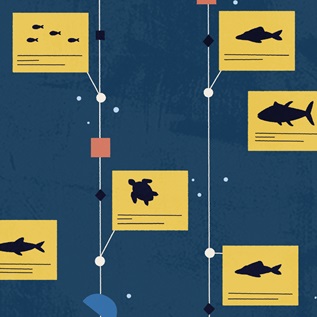Indian Ocean Fisheries Managers Should Adopt Sustainable Rules for Swordfish
World’s first modern management of species would show a commitment to sustainability

The Indian Ocean Tuna Commission (IOTC), one of five major regional fisheries management organizations (RFMOs) that focus on tuna, is responsible for more than its namesake species. Conservation and sustainable use of highly migratory tuna-like species, such as Spanish mackerel, billfishes and swordfish, have long been part of IOTC’s mandate. However, until recent years, the Commission has not worked much to improve management of these other valuable stocks.
But that could change soon. When IOTC meets in Bangkok from 13-17 May, member governments have the chance to adopt management procedures for both Indian Ocean swordfish and skipjack tuna that would lock in sustainability for these commercially important species. Similarly, the Commission should restart work to modernize oversight of the (also valuable) yellowfin tuna stock. To date, IOTC has renegotiated quotas every year but has emphasized short-term profit over long-term sustainability, and as a result has failed to prevent continued overfishing of this stock.
A management procedure (MP), also known as a harvest strategy, focuses on long-term objectives such as species health and sustained fishery profitability, with pre-agreed rules to determine future changes in allowable catch. Simply put, under harvest strategies if a fish population is healthy, catch levels can stay the same or even increase. If the population declines, catch limits will go down. These shifts and the levels at which they occur are pre-agreed among RFMO members, reducing the guesswork and politically driven negotiations in fishery management decisions.
The Indian Ocean swordfish population is healthy and the management procedure proposed by Australia would keep it that way for many years to come. By agreeing to the swordfish MP, IOTC members would show other RFMOs that this type of management can apply to their non-tuna species as well.
IOTC already showed its readiness for this type of management when it adopted the world’s first MP for bigeye tuna in 2022. To build on that momentum, IOTC should adopt the proposed swordfish MP without delay.
Concerns remain on tropical tuna management
Although IOTC is poised to make progress on swordfish, it is also facing another year of problems with its management of skipjack and yellowfin tunas. Skipjack management has been ineffective in recent years, with IOTC member States surpassing the catch limit every year since the Commission adopted a harvest control rule (HCR) in 2016, largely due to a stalemate on allocation of catch. An HCR is the operational part of an MP, the formula for calculating how much fishing can take place. However, HCRs are incomplete because they fail to specify the data inputs to the rule, as is done in a comprehensive MP. This can lead to inconsistent application of HCRs.
A proposal by the European Union to expand the HCR to a fully specified MP on skipjack will complete the work begun in 2016 and improve the scientific basis for setting the catch limit. However, that limit will still likely be exceeded if IOTC doesn’t also act with urgency to set an equitable distribution of catch to implement the MP and ensure a sustainable future for the skipjack fishery.
Likewise, yellowfin management has been failing for years, which is worrying because scientists have classified that population as overfished since 2015. Managers should end yearly negotiations of yellowfin catch limits, immediately reduce those limits to end overfishing and fast-track the development and adoption of a management procedure.
Improved vessel monitoring and inspection would also help
New and stronger rules for catch are important but also require effective enforcement. While IOTC requires many boats to have vessel monitoring systems (VMS) in place, there is no centralized way to monitor compliance and see a full picture of which vessels are doing what, where and when in IOTC waters. VMS tracks vessels via satellite and is critical for keeping fisheries sustainable and preventing illegal, unreported and unregulated fishing.
Across IOTC’s management area, members have different capacities for reporting VMS data from their vessels. Sometimes countries don’t share VMS data, stymieing opportunities to conduct effective enforcement, or even to collect scientific data on fisheries. This year, IOTC should adopt a plan to increase the consistency of VMS practices across all member governments and expedite a move towards centralized reporting.
For RFMOs, the ability to board and inspect fishing vessels on the high seas is crucial to monitoring of the resources under their mandates. Although a high seas boarding and inspection (HSBI) scheme exists within the Southern Indian Ocean Fisheries Agreement, another RFMO whose waters overlap with IOTC’s, no such scheme exists across the whole IOTC convention area. The EU, India and Seychelles seek to remedy that at this year’s meeting by adding an HSBI scheme for IOTC; Commission members should adopt that, adding another tool to their monitoring and surveillance toolbox.
Over the years, IOTC has missed some major opportunities to upgrade how it manages its fisheries, but it can take action this year to change that trajectory. By adopting harvest strategies for swordfish and skipjack tuna, IOTC can show a strong commitment to sustainable fisheries. But without movement on yellowfin, HSBI schemes or VMS, the Commission will remain bogged down and unable to move forward in other ways.
By prioritizing sustainability across all its managed species, IOTC can tilt the scales towards a brighter future for Indian Ocean high seas fisheries.
Glen Holmes works on Pew’s international fisheries project.
MORE FROM PEW
Explore Pew’s new and improved
Fiscal 50 interactive
Your state's stats are more accessible than ever with our new and improved Fiscal 50 interactive:
- Maps, trends, and customizable charts
- 50-state rankings
- Analysis of what it all means
- Shareable graphics and downloadable data
- Proven fiscal policy strategies
Welcome to the new Fiscal 50
Key changes include:
- State pages that help you keep track of trends in your home state and provide national and regional context.
- Interactive indicator pages with highly customizable and shareable data visualizations.
- A Budget Threads feature that offers Pew’s read on the latest state fiscal news.















